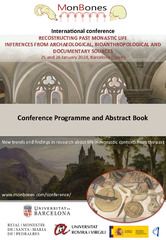Приказ основних података о документу
An Insight into Dietary Habits of St. Barbara Monastery (Southwestern Serbia) During the Early Modern Period: A Zooarchaeological Perspective
| dc.contributor | Lloveras, Lluís | |
| dc.contributor | Rissech, Carme | |
| dc.contributor | Nadal, Jordi | |
| dc.contributor | Castellano, Anna | |
| dc.contributor | Jové Sans, Montserrat | |
| dc.creator | Mladenović, Teodora | |
| dc.creator | Mladenović, Mladen | |
| dc.creator | Kajtez, Irina | |
| dc.creator | Vidosavljević, Vladan | |
| dc.date.accessioned | 2024-02-12T09:34:01Z | |
| dc.date.available | 2024-02-12T09:34:01Z | |
| dc.date.issued | 2024 | |
| dc.identifier.uri | http://rai.ai.ac.rs/handle/123456789/1588 | |
| dc.description.abstract | Since the late 14th century, throughout the Modern period, the Ottoman conquest of Serbia led to the devastation and desecration of churches and monasteries, looting of their assets, and the conversion of some sacred Christian sites into mosques. Despite this, the Serbian Orthodox Church persisted and even expanded during the late 15th and early 16th centuries. While some monasteries fell into disrepair, others prospered, such as the St. Barbara Monastery, located on Reljina Gradina near Novi Pazar (Southwestern Serbia). Based on written sources, the monastery was built during the 16th century, which was proved by archaeological excavations. It was burned down at the end of the 17th century. The excavations have also confirmed an older Medieval necropolis beneath the monastery buildings. The monastery consists of the church, east and west blocks of buildings, and a surrounding wall. It also includes a well, refectory, and kitchen. During the excavations in 2022 and 2023, a small surface in the western part within and outside of the churchyard was excavated. Archaeological material of the 16th and 17th centuries was not abundant, consisting mostly of kitchen and tableware, and less numerous small finds and faunal remains. This paper aims to present faunal analysis results from St. Barbara Monastery, and reveal the dietary habits and characteristics of everyday life of monastery inhabitants from a zooarchaeological perspective. The analysis suggests that domestic animal meat and fish were predominantly consumed. Caprine remains were the most abundant, as the most significant source for exploitation of primary and secondary products. Albeit small, the faunal assemblage from a few contexts of St. Barbara uncovered by now is significant since it is the only known Modern period monastery faunal collection from the territory of Serbia. | sr |
| dc.language.iso | en | sr |
| dc.publisher | Barcelona : University of Barcelona | sr |
| dc.publisher | Tarragona : University Rovira i Virgili | sr |
| dc.publisher | Barcelona : Royal Monastery of Santa Maria de Pedralbes | sr |
| dc.relation | info:eu-repo/grantAgreement/ScienceFundRS/Ideje/7750265/RS// | sr |
| dc.rights | openAccess | sr |
| dc.rights.uri | https://creativecommons.org/licenses/by/4.0/ | |
| dc.source | MonBones – Reconstructing Past Monastic Life. Inferences from Archaeological, Bioanthropological and Documentary Perspectives, 25-26th January, Barcelona, Spain | sr |
| dc.subject | Early Modern Period | sr |
| dc.subject | St. Barbara Monastery | sr |
| dc.subject | faunal remains | sr |
| dc.subject | dietary habits | sr |
| dc.subject | Serbia | sr |
| dc.title | An Insight into Dietary Habits of St. Barbara Monastery (Southwestern Serbia) During the Early Modern Period: A Zooarchaeological Perspective | sr |
| dc.type | conferenceObject | sr |
| dc.rights.license | BY | sr |
| dc.citation.epage | 44 | |
| dc.citation.spage | 44 | |
| dc.identifier.fulltext | http://rai.ai.ac.rs/bitstream/id/4519/An_Insight_into_Dietary_Habits_of_St_Bar.pdf | |
| dc.identifier.rcub | https://hdl.handle.net/21.15107/rcub_rai_1588 | |
| dc.type.version | publishedVersion | sr |


